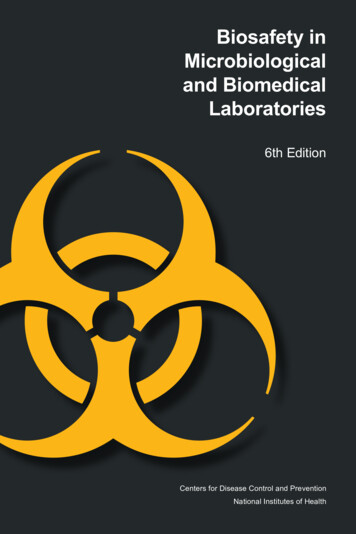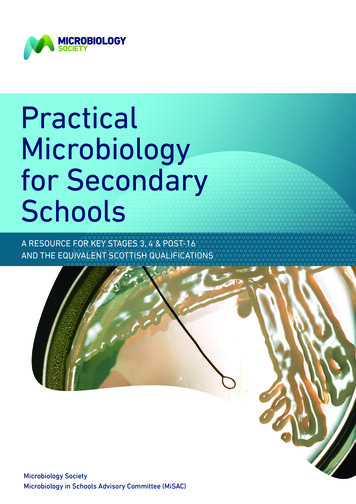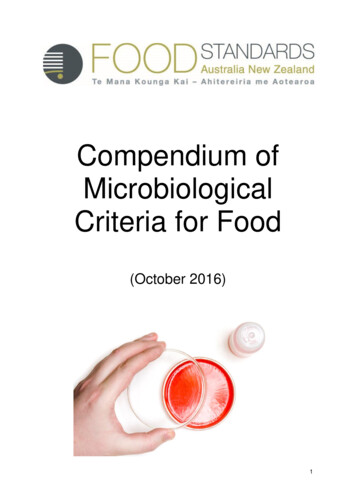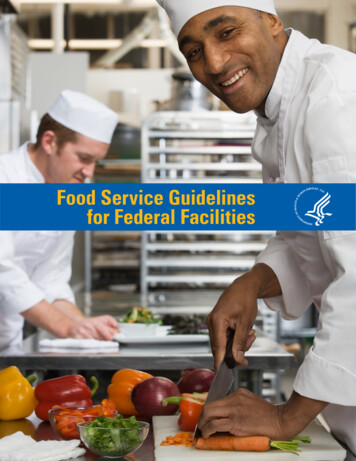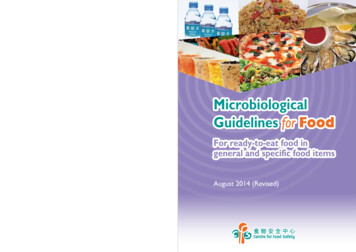
Transcription
MicrobiologicalGuidelines for FoodFor ready-to-eat food ingeneral and specific food itemsAugust 2014 (Revised)
Microbiological Guidelines for Food(For ready-to-eat food in general and specific food items)August 2014(revised)Centre for Food Safety
This set of Guidelines is published bythe Centre for Food Safety, Food and Environmental Hygiene Department.The technical content has been developedin consultation withthe Expert Committee on Food Safetyof the Food and Environmental Hygiene Department.Correspondence:Risk Assessment SectionCentre for Food SafetyFood and Environmental Hygiene Department43/F, Queensway Government Offices,66 Queensway, Hong Kong.Tel: (852) 2867 5699 Fax: (852) 2893 3547Email: enquiries@fehd.gov.hk
Microbiological Guidelines for FoodPrefaceAs part of the Government’s ongoing efforts to enhance food safety for theprotection of public health and consumer interest, the Administration conductsreview on microbiological standards and guidelines for food and amends themwhere necessary by taking international/ national standards and guidelines aswell as local situation into consideration.In light of changing needs and expert views, the MicrobiologicalGuidelines for Ready-to-eat Food (the Guidelines) established in 2002 wereamended under the advice of the Expert Panel on Microbiological Safety ofFood in 2007. Subsequently in 2009, supplementary information to theGuidelines regarding the microbiological criteria for bottled waters and edibleice and the revised microbiological criteria for non-bottled drinks wereestablished under the advice of an Ad Hoc Working Group on MicrobiologicalSafety of Food formed under the Expert Committee on Food Safety (ExpertCommittee) in 2008.In order to keep the local microbiological guidelines abreast of theinternational development and advancement of food science and technology,the Ad Hoc Working Group on Microbiological Safety of Food 2011 (WorkingGroup) was formed under the Expert Committee to provide professionalrecommendation based on the latest situation.Apart from textual amendments, major revisions on the following aspectswere recommended by the Working Group - (1) modifying the existingmicrobiological criteria as well as establishing additional microbiologicalcriteria with reference to international/ national standards and guidelines, (2)incorporating microbiological criteria stipulated in the supplementaryinformation to the Guidelines, (3) revising the classification and nomenclatureof microbiological quality and (4) putting in additional information on commonfoodborne pathogens in Appendix I for reference. The trade was consulted onthe proposed amendments and the Guidelines were endorsed by the ExpertCommittee. Since the revised Guidelines would include microbiologicalcriteria for both ready-to-eat and non-ready-to-eat food e.g. powdered infantformula, the title of the Guidelines is also changed to “MicrobiologicalGuidelines for Food”.The revised Guidelines supersede those previously issued and serve tofacilitate enforcement in monitoring and controlling of microbiological qualityof food as well as facilitating the trade in devising measures to improve foodsafety.Centre for Food SafetyFood and Environmental Hygiene DepartmentAugust 2014-i-
Ad Hoc Working Group on Microbiological Safety of Food 2011The Expert Committee on Food Safety (Expert Committee), set upunder the Centre for Food Safety, is responsible for advising the Director ofFood and Environmental Hygiene in the formulation of food safety measures,review of food safety standards in light of international practices, trends anddevelopments, as well as risk communication strategies. In 2011, the ExpertCommittee endorsed to set up the Ad Hoc Working Group on MicrobiologicalSafety of Food 2011 (Working Group) to provide advice on the review of“Microbiological Guidelines for Ready-to-eat Food” (the Guidelines) in HongKong.The Working Group consists of academics, professionals,representatives from Government Departments and members of the ExpertCommittee. The Working Group is chaired by Consultant (CommunityMedicine) (Risk Assessment and Communication) with secretariat supportprovided by Risk Assessment Section of the Centre for Food Safety. Officialsfrom the Department of Health and Agriculture, Fisheries and ConservationDepartment provide advice on issues fall under their purviews.The non-official members are as follows:Members of Expert Committee on Food Safety (2010-2012)Dr CHUA Sin-bin Principal Consultant,Agrifood Technologies Pte Ltd., SingaporeDr Matthew NGConsultant Physician,Department of Medicine,Tung Wah HospitalExperts from Overseas and MainlandDr Duncan CRAIG Manager/Principal Microbiologist,Risk Assessment – Microbiology Section,Food Standards Australia New ZealandProf. LIU Xiu-mei Scientist and Professor,National Institute of Nutrition and Food Safety,Chinese Center for Disease Control and PreventionLocal ExpertsDr CHEN ShengDr HO Pak-leungAssistant Professor,Department of Applied Biology & Chemical Technology,The Hong Kong Polytechnic UniversityAssociate Professor,Department of Microbiology,The University of Hong Kong- ii -
Prof. Margaret IPProfessor,Department of Microbiology,The Chinese University of Hong KongDr NG Tak-keungConsultant Microbiologist,Department of Pathology,Princess Margaret Hospital- iii -
TABLE OF CONTENTSIntroduction to Microbiological Guidelines for Food1-2Chapter IMicrobiological Criteria for Ready-to-eatFood in General - Aerobic Colony Count(ACC) and Hygiene Indicator Organisms3-10Chapter IIMicrobiological Criteria for Ready-to-eatFood in General - Specific FoodbornePathogens11-13Chapter IIIMicrobiological Criteria for Specific FoodItems14-21References22Appendix ICommon Foodborne Pathogens23-34Appendix IIGuidance Notes on Sampling Plan forMicrobiological Analysis35-38- iv -
Introduction to Microbiological Guidelines for Food- Recommendations for Food Safety Monitoring in Hong Kong-Food safety control aims to safeguard public health and provideassurance on food safety. To this end, microbiological analyses are usefulways to assess the safety and quality of food involved. This set of Guidelinespresents the recommended microbiological criteria for (1) ready-to-eat food ingeneral and (2) specific food items.Purpose of the Guidelines2.In the Hong Kong Special Administrative Region, the legal powersand instruments for the enforcement of microbiological safety of food areprovided for in the Public Health and Municipal Services Ordinance, Chapter132 (the Ordinance). Section 54 of the Ordinance stipulates that it is anoffence to sell food that is unfit for human consumption. General protectionfor purchasers of food is provided in Section 52 of the Ordinance when aperson may be guilty for selling to the prejudice of a purchaser any food whichis not of the nature, substance or quality demanded by the purchaser. Legalmicrobiological standards for some specified foods are stipulated in itssubsidiary legislations.3.Microbiological Guidelines are criteria indicating the microbiologicalcondition of the food items when there are no established microbiologicalstandards. They also supplement any existing legislative microbiologicalstandards so as to reflect the safety and hygienic quality of the food. Thepurpose of this set of Guidelines is to provide assistance to officers in theinterpretation of microbiological analyses of foods and give recommendationson the appropriate follow-up action to monitor and control food safety. It alsoserves to facilitate the trade in devising measures to improve their food safetypractices.Use of the Guidelines4.The microbiological criteria for (i) ready-to-eat food in general Aerobic colony count (ACC) and Hygiene indicator organisms, (ii) ready-to-eatfood in general – specific foodborne pathogens and (iii) specific food items are-1-
listed in Chapters I to III respectively.5.Microbiological methods are appended to some microbiologicalcriteria which are given in the relevant Codex standards and code of hygienicpractices. Other equivalent methods that have been validated to provideappropriate sensitivity, reproducibility, reliability etc. could be employed.Preference should be given to methods which have been validated for thecommodity concerned especially in relation to reference methods elaborated byinternational organisations. This is also applicable to other microbiologicalcriteria in this set of Guidelines, which have no microbiological methodappended.6.Additional information on the Common Foodborne Pathogens(Appendix I) and the Guidance Notes on Sampling Plan for MicrobiologicalAnalysis (Appendix II) are supplemented to this set of Guidelines for reference.-2-
Chapter I. Microbiological Criteria for Ready-to-eat Food in General- Aerobic Colony Count (ACC) and Hygiene Indicator OrganismsIntroductionMicrobiological criteria in Chapters I and II are intended forassessing the microbiological quality of ready-to-eat food in general. Thesecriteria are based on the local “Microbiological Guidelines for Ready-to-eatFood (May 2007 Revised)” and are revised with reference to the “Guidelinesfor Assessing the Microbiological Safety of Ready-to-Eat Foods Placed on theMarket”1 published by the Health Protection Agency in the United Kingdom inNovember 2009 and the advice from the Ad Hoc Working Group onMicrobiological Safety of Food 2011 after taking local situation intoconsideration.2.The criteria stated in Chapters I and II apply to ready-to-eat food ingeneral. “Ready-to-eat food” means food intended by the producer or themanufacturer for direct human consumption without the need for cooking orother processing effective to eliminate or reduce to an acceptable level themicroorganisms of concern.13.However, some microbiological criteria set out in Chapter III apply tocertain food items which may not be ready-to-eat. Chapters I, II and IIIshould be read together for the microbiological criteria of specified food. Forexample, for live or raw bivalve molluscs intended for direct consumption, therelevant Escherichia coli and Salmonella spp. criteria are stipulated in ChapterIII. As regards other microbiological criteria, they are set out in Chapters Iand II.Components of Microbiological Criteria for Ready-to-eat Food in General4.The microbiological limits for ready-to-eat food in general consist ofthree components: Aerobic colony count (ACC); Hygiene indicator organisms – E. coli and Enterobacteriaceae; Specific foodborne pathogens – ten specific bacterial pathogens.-3-
5.The microbiological criteria for ACC and hygiene indicator organismsare covered in this Chapter while those for specific foodborne pathogens areincluded in Chapter II.Classification of Microbiological Quality6.The microbiological assessment of ready-to-eat food on the abovethree components will lead to the classification of microbiological quality intoone of the following three classes1:(a)Satisfactory: test results indicating good microbiological quality.(b)Borderline: test results that are not unsatisfactory but are also notsatisfactory, are on the upper limit of acceptability and which indicate thepotential for development of public health problems and of unacceptablerisk.(c)Unsatisfactory: For ACC, test results which indicate investigatingreasons for high count may be considered. For hygiene indicatororganisms, test results that require remedial action. For pathogens, testresults at levels which indicate a product that is potentially injurious tohealth and/or unfit for human consumption and require immediateremedial action.7.Suggested actions to be taken by officers for each class i.e.satisfactory, borderline and unsatisfactory in response to the results of ACC,hygiene indicator organisms and specific foodborne pathogens in ready-to-eatfood in general are summarised in Table 1.1.-4-
Table 1.1 Summary on suggested actions (not exclusive) to be takenby officers for each class in response to the results of ACC, hygieneindicator organisms and specific foodborne pathogens in ready-to-eatfood in generalACCHygiene indicatorSpecific foodborneorganismspathogens(NB: Perform riskassessment before anyfurther action)No action required.SatisfactoryBorderlineConsider the source Parties concerned (e.g. Riskoffood vendors)the(producer/retailer advisedshouldtowillincreasebe proportional to the levelsreview detected.Partiesetc.) and the stage of cooking and all hygiene concerned (e.g. vendors)shelfbefore procedureslifeincluding should be advised todetermining action. cleaning.Ifotherfromsamples takingtheConsider investigate and find outinvestigative the causes and to adoptsame food samples.Action measures to improve thesource are also of should be proportional situation.borderlinequality, to the levels detected.further investigationConsidertaking investigative foodsamples.may be appropriate.Unsatisfactory ConsiderParties concerned (e.g. Immediate investigation;investigating reasons vendors)shouldfor high count.toadvisedbe Parties concerned (e.g.review vendors)shouldbecooking and all hygiene instructed to stop sale ofproceduresincluding food item in question,cleaning.Take investigate immediatelyinvestigativefood and find out the causessamples.and to adopt measures toimprovethesituation.Take investigative foodsamples.In addition,warning letters, sourcetracingandenforcementotheractionsshould be considered.-5-
Aerobic Colony Count (ACC)“Aerobic colony count (ACC)”, also known as the total viable countor standard plate count, is the total number of bacteria able to grow in anaerobic environment in moderate temperature. It is an indicator of quality, notsafety, and cannot directly contribute towards a safety assessment ofready-to-eat food. In addition, ACCs can provide useful information aboutthe general quality and remaining shelf life of the food in question, and thushighlight potential problems of storage and handling since production; howeverthey are not deemed a priority in a risk based analysis.12.In general, immediate action in response to high ACCs is not usuallywarranted except for shelf-stable canned or bottled food products immediatelyafter opening (Food Category 1, Table 1.2). The ACC level in ready-to-eatfoods will depend initially on the type and duration of processing that the foodhas received during production. Thereafter the level will depend on how it ishandled and stored.13.Guidance on the interpretation of results for ACC levels in variousready-to-eat foods is provided in Table 1.2.-6-
Table 1.2 Guidance on the interpretation of results for ACC levels [30 C/48 hours] in various ready-to-eat foodsFood Category a1. Ambient stable canned, bottled,cartoned and pouched foods immediatelyafter removal from container b2. Foods cooked immediately prior tosale or consumption3. Cooked foods chilled but withminimum handling prior to sale orconsumption; canned pasteurised foodsrequiring refrigeration4. Bakery and confectionery productswithout dairy cream, powdered foods5. Cooked foods chilled but with somehandling prior to sale or consumption6. Non-fermented dairy products anddairy desserts, mayonnaise andmayonnaise based dressings, cookedsauces7. Food mixed with dressings, dips,pastes8. Extended shelf life food productsrequiring refrigeration9. Raw ready-to-eat meat and fish, coldsmoked fish10. Preserved food products – pickled,marinated or salted11. Dried foods12. Fresh fruit and vegetables, productscontaining raw vegetablesExamplesCanned products such as tuna, salmon, corned beef, soups, stews, dessertsand fruit; ultra-high-temperature (UHT) productsResult (colony-forming unit (cfu)/g)Satisfactory Borderline Unsatisfactory 10N/ANote c 103103- 105 105 104104- 107 107 104104- 106 106 105105- 107 107 105105- 107 107Coleslaw, dips, taramasalata, houmous 106106- 107 107Modified atmosphere packaging (MAP) or vacuum packed products, e.g.meat, fish, fruit and vegetablesSushi, sashimi, smoked salmon, gravalax 106106- 108 108 d 106106- 107 107N/AN/AN/AN/AN/AN/AN/AN/AN/ATakeaway food, burgers, kebabs, sausages, pizza , ready meals (cook/chilland cook/freeze) after regeneration, dim sum, rice, noodlesWhole pies, sausage rolls, samosas, flans, quiches, chicken portions;canned ham requiring refrigeration, pasteurised foods including fruit juiceand soups; dessertsCakes without dairy cream, soup powders, milk powder, powdered dairyproducts, other reconstituted powdered foods ready to eat afterreconstitution or warmingSliced meats, cut pies, pâté, sandwiches without salad, hot smoked fish(mackerel, etc.), molluscs, crustaceans and other shellfish out of shell,non-prepackaged cold beverages with solid ingredients but without dairycomponents (iced green tea with red bean, etc.)Most butter, fresh cheese (mascarpone, paneer), trifle with dairy cream,satay, cakes with dairy cream, non-prepackaged cold beverages with solidingredients and dairy components (iced milk tea with pearl tapioca, etc.)Pickled or salted fish, cooked shellfish in vinegar, vegetables in vinegar oroil, herbs, spicesFruits, berries, vine fruits, nuts, sunflower seeds, herbs, spices, dried fishWhole fruit, pre-prepared fruit salads, vegetable crudités, salads,sandwiches with salad, mixed commodity salads containing rawvegetables, non-prepackaged cold beverages with solid and fresh fruitingredients (chilled fresh mango juice with pomelo and sago, etc.)-7-
Food Category aExamples13. Fermented, cured and dried meats,Continental sausages/salamis, jerky, sauerkraut, olives, bean curd,fermented vegetables, ripened cheesescheddar, stilton, brie, fermented milk drinks and butter, yoghurt, etc14. Cooked meat products that may be Chinese poached chickens, roasted ducks and roasted porkdisplayed for sale at ambient temperaturefor a limited period of time e.g. siu-meiand lo-meiN/A denotes “Not applicable”Result (colony-forming unit (cfu)/g)Satisfactory Borderline UnsatisfactoryN/AN/AN/A 105105- 106 106Notes:a. For food items that are not included in these food categories, their ACC level should be interpreted taking into account the raw ingredients used, and thenature and degree of processing before sale.b. Most products are normally sterile when sampled from the container but if they are consumed after subsequent further preparation then assess them asCategory 5.c. These products are ‘Unsatisfactory’ if spore forming anaerobes are present but these require special tests for detection and enumeration. Spore formingaerobes are also usually absent in foods that have been cooked in their container but low levels may occur in canned fish products.d. Check for signs of spoilage. Lactic acid bacteria can grow well at refrigeration temperatures and do not grow well aerobically. Spoilage will eventuallyoccur at a level of around 109 cfu/g due to the production of lactic acid. If the predominant organisms are Gram-negative bacteria, spoilage is likely to benoticeable at 107 to 108 cfu/g, e.g. taints, discolouration, and slime produced by pseudomonads, slime produced by other Gram-negative bacteria.-8-
Hygiene Indicator Organisms“Hygiene indicator organisms” refers to the selected surrogatemarkers. The main objective of using bacteria as indicators is to reflect thehygienic quality of food.2.E. coli is a commonly used faecal indicator organism. Its presencein food generally indicates direct or indirect faecal contamination.Substantial number of E. coli in food suggests a general lack of cleanliness inhandling and improper storage.3.Enterobacteriaceae is a large group of biochemically and geneticallyrelated bacteria used to assess the general hygiene status of a food product.Their presence in heat treated food indicates inadequate cooking orpost-processing contamination.In addition, some members ofEnterobacteriaceae can contribute to the formation of histamine(scombrotoxin) in foods such as scombroid fish and occasionally somecheeses if these are not processed properly and/or stored at an adequaterefrigeration temperature.14.Guidance on the interpretation of results for hygiene indicatororganisms in ready-to-eat food in general is provided in Table 1.3.-9-
Table 1.3 Guidance on the interpretation of results for hygiene indicator organisms in ready-to-eat food in generalHygiene indicator organismSatisfactory*aEnterobacteriaceae 102Escherichia coli b 20*To be implemented when the testing capacity for this criterion is ready.Result (colony-forming unit (cfu)/g)Borderline102 - 10420 - 102Unsatisfactory 104 102Notes:a. The criterion listed for Enterobacteriaceae applies to heat treated food, fishes, and cheeses (excluding cheeses ripened using a culture of Hafnia alvei orProteus vulgaris). It does not apply to fresh fruit and vegetables or food that contains fresh fruit and vegetables as ingredients e.g. sandwiches withsalad, because these food types can contain high levels of Enterobacteriaceae as part of their normal micro-flora.b. Criterion does not apply to cheeses made from raw milk.- 10 -
Chapter II. Microbiological Criteria for Ready-to-eat Food in General –Specific Foodborne PathogensSpecific Foodborne PathogensExamination for foodborne pathogens (bacteria that may cause foodpoisoning) in ready-to-eat food contributes to food safety.2.The symptoms of food poisoning vary from nausea and vomiting (e.g.caused by Staphylococcus aureus enterotoxin), through diarrhoea anddehydration (e.g. caused by Salmonella spp. and Campylobacter spp.) tosevere conditions such as septicaemia, meningitis, paralysis and death (e.g.caused by invasive Listeria monocytogenes and in the rare cases of botulismcaused by Clostridium botulinum toxin). The infective doses of differentfoodborne pathogens vary from less than ten to more than 108 organisms.General information on the common foodborne pathogens included in this setof guidelines is provided in Appendix I.3.Guidance on the interpretation of results for specific foodbornepathogens in ready-to-eat food in general is provided in Table 2.1.- 11 -
Table 2.1 Guidance on the interpretation of results for specific foodborne pathogens in ready-to-eat food in generalResult (colony-forming unit (cfu)/g unless otherwise specified)CriterionCampylobacter spp. (thermotolerant)Escherichia coli O157 (and *other Shigatoxin-producing E. coli (STEC))Salmonella spp.Vibrio cholerae (O1 and O139)Shigella spp. aListeria monocytogenes For refrigerated food b (excluding frozenfood) or food intended for infants For other ready-to-eat foodVibrio parahaemolyticusStaphylococcus aureus and othercoagulase-positive staphylococciClostridium perfringensBacillus ally injurious to health and/orunfit for human consumptionn.d. in 25gn.d. in 25gN/AN/ADetected in 25gDetected in 25gn.d. in 25gn.d. in 25gn.d. in 25gN/AN/AN/ADetected in 25gDetected in 25gDetected in 25gn.d. in 25g cN/ADetected in 25g c 10 d 20 2010 - 100 d20 - 10320 - 104 100 d 103 104 10 10310 - 104103 - 105 104 105n.d. not detected; N/A not applicable*To be implemented when the testing capacity for this criterion is ready.Notes:a. Shigella spp. would be tested in the cases of food poisoning investigation or food complaint if the organism is implicated but not recommended for routinesurveillance.b. This criterion applies to all refrigerated food (excluding frozen food) unless there is scientific evidence supporting that the food concerned does notsupport the growth of Listeria monocytogenes under refrigeration. Reference can be made to the Codex Guidelines on the Application of General- 12 -
Principles of Food Hygiene to the Control of Listeria monocytogenes in Food (CAC/GL 61-2007).c. ISO 11290-1:1996/Amd 1:2004. Other methods that provide equivalent sensitivity, reproducibility, and reliability can be employed if they have beenappropriately validated.d. ISO 11290-2:1998/Amd 1:2004. Other methods that provide equivalent sensitivity, reproducibility, and reliability can be employed if they have beenappropriately validated.- 13 -
Chapter III. Microbiological Criteria for Specific Food ItemsIntroductionThis chapter contains microbiological criteria for specific food items,including ready-to-eat food.2.The microbiological criteria for bottled waters, edible ice andnon-bottled drinks included in the Supplementary Information toMicrobiological Guidelines for Ready-to-eat Food (February 2009) wereestablished and adopted by an Ad Hoc Working Group on MicrobiologicalSafety of Food formed under the Expert Committee on Food Safety in 2008.These criteria are incorporated in this chapter while the microbiologicalcriteria for natural mineral waters are revised in accordance with the latestversion of the Codex Code of Hygienic Practice for Collecting, Processingand Marketing of Natural Mineral Waters (CAC/RCP 33-1985, revised 2011).2On the other hand, with consideration of local situation and expert opinion,the microbiological criteria for powdered formulae for infants and youngchildren, treated, ready-to-eat spices as well as live or raw bivalve molluscsintended for direct consumption are adopted with reference to the respectiveCodex Code of Hygienic Practices and standard i.e. Code of Hygienic Practicefor Powdered Formulae for Infants and Young Children (CAC/RCP 66-2008,revised 2009), Code of Hygienic Practice for Spices and Dried AromaticPlants (CAC/RCP 42-1995), Standard for Live and Raw Bivalve Molluscs(CODEX STAN 292-2008, amendment 2013) and Code of Practice for Fishand Fishery Products (CAC/RCP 52-2003, amendment 2013).3,4,5,63.Some food items that are included in Chapter III (such as bottledwaters, edible ice, non-bottled drinks, ready-to-eat spices and live or rawbivalve molluscs intended for direct consumption) also belong to ready-to-eatfood. Hence, the microbiological criteria stipulated in Chapters I and II areapplicable to these ready-to-eat food as well except for criteria that are laiddown in this chapter.Definition4.“Natural mineral water” is clearly distinguishable from ordinarydrinking water. The former is characterised by its content of certain mineralsalts, trace elements or other constituents. Natural mineral water is collected- 14 -
directly from natural or drilled sources from underground water in which theoriginal microbiological purity and chemical components are guaranteed. Itis also packaged close to the point of emergence of the source under hygieniccondition and not subjected to any treatment other than those permitted.75.“Non-bottled drinks” are classified as restricted food specified inSchedule 2 to the Food Business Regulation (Cap. 132X). Save with thepermission of the Director of Food and Environmental Hygiene, no personshall sell non-bottled drinks. In this connection, a restricted food permit or arelevant permission on a food business licence is required for sellingnon-bottled drinks. Permittees / Licensees shall take all necessary steps toensure that the non-bottled drinks are free from contamination. In order tomonitor the hygiene condition under which the non-bottled drinks areprepared, there is a licensing condition on bacteriological standards fornon-bottled drinks imposed on the concerned restricted food permits and foodbusiness licences.6.“Infant formula” means a breast milk substitute speciallymanufactured to satisfy, by itself, the nutritional requirements of infantsduring the first months of life up to the introduction of appropriatecomplementary feeding.37.“Follow-up formula” means a food intended for use as a liquid partof the weaning diet for the infant from the 6th month on and for youngchildren.38.“Spices” include dried aromatic plants, relate to natural driedcomponents or mixtures thereof, used in foods for flavouring, seasoning andimparting aroma. The term applies equally to spices in the whole, broken orground form.49.“Live bivalve molluscs (intended for direct consumption)” areproducts that are alive immediately prior to direct consumption. Presentationincludes the shell.510.“Raw bivalve molluscs (intended for direct consumption)” areproducts that were alive immediately prior to the commencement ofprocessing for direct consumption. They have been shucked and/or frozenand/or processed to reduce or limit target organisms while essentially retaining- 15 -
the sensory characteristics of live bivalve molluscs.are marketed in a frozen or chilled state.5Raw bivalve molluscsSome Specific Microbiological Parameters Included in Chapter III11.Coliform bacteria can originate from faecal contamination or fromthe environment. Coliform bacteria are normally not present in naturalmineral water sources. They are considered as an indicator of contaminationof the water at source or during the packaging process.2 In addition, coliformbacteria should be absent immediately after disinfection, and the presence ofthese organisms in water indicates inadequate treatment.12.Enterococci are a sub-group of faecal streptococci. Compared to E.coli and coliforms, they tend to survive longer in the water environment andare therefore used as an additional indicator of faecal contamination. 213.The spores of spore-forming sulphite-reducing anaerobes are veryresistant towards various kinds of environmental stresses. These bacteria canoriginate from faecal contamination and due to the length of their survival inunfavourable environments, they are usually used as an indicator of faecalcontamination. 214.Pseudomonas aeruginosa is a common environmentalmicroorganism and can be found in faeces, soil, water and sewage. It canmultiply in water environments and also on the surface of suitable organicmaterials in contact with water. Pseudomonas aeruginosa is not a normalcomponent of the natural flora of natural mineral waters. Its presence isconsidered as an indicator of contamination of the water at source or duringthe packaging process. 215.Enterobacter sakazakii (Cronobacter spp.) is a pathogen thatgenerally causes disease only in people with weak
Appendix II Guidance Notes on Sampling Plan for Microbiological Analysis 35-38 - 1 - Introduction to Microbiological Guidelines for Food - Recommendations for Food Safety Monitoring in Hong Kong- Food safety control a

